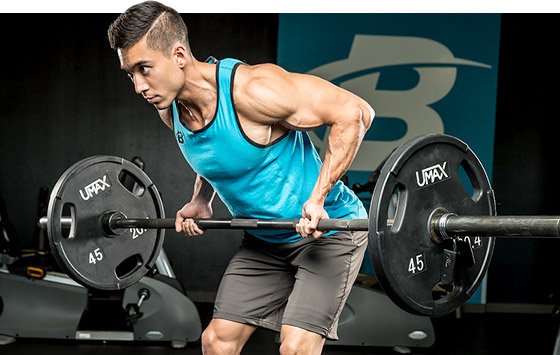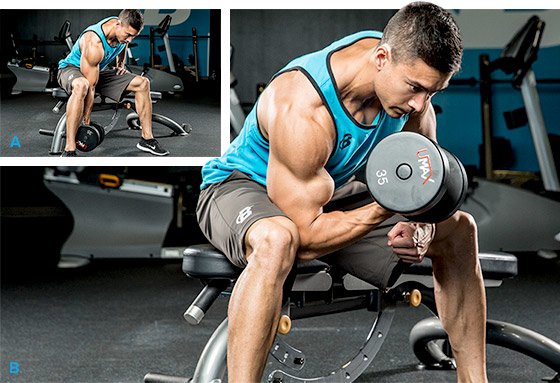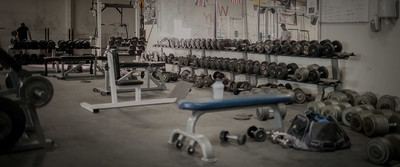We all have body parts and specific muscle groups we want to improve, but complaining about them doesn't solve the problem. If you really want to transform a weakness into a strength, you need a smart strategy that effectively targets the muscle you want to mold. This is especially true for your biceps peak.
To build a towering biceps peak, you need to divide and conquer: "divide" in the sense that your biceps have two heads, and the long (outer) head is the one you see knotted up when you flex your arm, forming the peak; and "conquer," as in finding ways to directly target that particular head with exercises, subtle changes in hand position, and post-failure intensity boosters that initiate growth processes.
It's worth noting that, anatomically, the long head is emphasized over the short head when you take a closer grip on a barbell, and when it gets a better stretch, as when doing incline-bench dumbbell curls. On the incline bench, your upper arms are behind the plane of your body, enabling the long head to be fully stretched. (A muscle is capable of a stronger contraction when it's completely stretched first.)
If, like me, you weren't in the front of the genetic line for big, peaked arms, it's time for you to give these seven peak-building strategies a try. Incorporate as many of them as you can into your current routine. If you have other ideas, please include them in the comments section at the conclusion of the article.

Standing Barbell Curl
1. Train Your Biceps After A Rest Day
What's the best way to ensure you have a great workout? By making sure you're well-rested beforehand, have plenty of fuel in your tank, and are mentally fresh to push yourself. More often than not, that's after a day away from the gym—at least one in which you took the day to actually recover instead of spending the wee hours in some club.
If your biceps are your top priority, do them first after a rest day. Because it's a short workout—usually 30 minutes, tops—it isn't too difficult to maintain high-octane intensity over the course of your workout. And if you train biceps with triceps, consider even hitting your biceps first since they're your main target.
Rest also means giving your arm flexors at least 48 hours between workouts. Follow a training split in which you space your back workout either two days before or two days after your arm day. Working your biceps on Mondays and back on Tuesdays provides inadequate recovery time and can hinder overall arm gains. Whatever split you follow, just use rest days judiciously and be cautious when planning your back attack.
2. Train Your Biceps Twice Over The Course Of Your Split
While you don't want to train your biceps on consecutive days, there's no reason you can't do them twice over the course of your training split. This strategy works especially well if you follow a longer split, say 5-6 days.
Given that the biceps are a relatively small muscle group that recovers faster than larger body parts like legs or back, you can train them more frequently, at least in the short-term. Every third or fourth day works fine, so long as you don't train them immediately before or after a back day.
When following this approach, consider using biceps workouts that are very different from each other, rather than repeating the same workout on both days. In this case, you might make one session a general mass-building workout that includes exercises for both the long and short heads, as well as the brachialis, and focus the other workout specifically on the long head with a variety of moves, grips, and rep ranges.
You can even change up the advanced techniques you use, using forced reps during one workout and negatives in the other. The idea here is to work the biceps in very different ways for optimal results.
3. Do Biceps After A Back Workout
If you're following a shorter training split or trying to get in two biceps workouts per week, it might make sense to train them after back. Since both are pulling muscles—the biceps are engaged during most multijoint back movements—it makes sense to do them together. You don't, however, want to train you biceps before your back.
The biceps get a good workout already in back training, so most people reason that they might as well finish them off. What you want to avoid is training biceps the day before or after back so that you're not working this muscle group on consecutive days, as stated above. Even a smaller body part like the biceps requires a minimum of two days' rest between arm workouts.

"The biceps get a good workout already in back training, so most people reason that they might as well finish them off."
4. Choose a Superior Mass-Builder And Use Challenging Weights
There's no shabbier way to start your workout than with the wrong choice of exercises. What makes a given exercise right or wrong? The amount of weight you can lift. Multijoint exercises are the clear winner when it comes to larger muscle groups, but with biceps, you're left with a battery of single-joint movements.
So let's go back to the original question: What exercise can you move the most weight with? Let me give you two sample choices here: concentration curl or standing barbell curl. This should be easy to pick—standing barbell curl is the clear winner—but many guys still start their arm workouts with light exercises. It's like putting reverse-grip press-downs early in your triceps routine, or doing leg extensions first on leg day. Sure, it can work in a pre-exhaust (in which you intentionally order the exercises with single-joint movements first), but not as part of your staple mass-building routine.
Another reason the standing curl is such a good choice is that you can generate a bit of momentum through your hips once you approach muscle failure. This doesn't mean you should use a ridiculously heavy weight and start rocking back and forth on your very first rep, but after you've done 6-8 reps with clean form, a bit of body English can help you get past a sticking point for another rep or two. Use just enough momentum to get past that sticking point. If you have to throw your back into the movement, you'll end up with a lower-back strain.
As far as challenging weights go, there's no reason not to push yourself early in your routine when your energy levels are high. Rather than doing 3 sets of 10, go a little heavier and choose a weight in which you might be able to do only 6-8 reps.

Concentration Curl
5. Find Ways To Emphasize The Long (Outer) Head
One of the reasons you're so strong in the standing barbell curl mentioned above is because you're using both biceps heads as you complete it. You can put more emphasis on the long head by shifting your grip inward, internally rotating the shoulders.
Use a grip an inch or two inside shoulder width, so you can better focus on the long head. If you've always done your barbell curls with the same grip, try a couple of closer-grip sets and a few wider-grip sets that—you guessed it—better emphasize the short head. While you can't isolate one particular area of the arms, you can shift the emphasis, which is what we're doing here.
Training Tip
By taking a grip a few inches inside shoulder width on your standing curls, you can better emphasize the biceps long head, the muscle that creates the peak when you flex your arm.
There are other ways to target the long head, too. Incline-bench dumbbell curls are a great way to stretch the long head, since your upper arms remain behind the plane of your body. Two other exercises that emphasize the long head are hammer curls and cable hammer curls, which target the long head and brachialis, a muscle that lies deeper than the biceps brachii but assists in elbow flexion and adds arm girth.
Including one or more of these exercises in your biceps workout will increase the stress of the long head, assisting you in further development of the coveted peak.

Incline-Bench Dumbbell Curl
6. Boost Your Intensity With Advanced Techniques
Choosing the right variations of exercises and using the right weights is a good start, but you still have to lift it. When it comes to initiating growth processes at the cellular level, you won't get away with stopping your sets short of muscle failure. In fact, taking 1-2 sets of each exercise past failure is your recipe for growth. Here are a few advanced training techniques that work especially well with biceps:
- Forced reps: A good training partner is worth his weight in gold; even if you don't have one, try to get a spot on your heaviest set of curls. With a couple of forced reps, your partner provides just enough help to get you past the sticking point, enabling you to do a few extra reps past failure. This is best done on barbell curls. You can also do it with dumbbells, but your spotter will have to work back and forth if you alternate sides as you curl.
- Dropsets: This technique is best done with cables or dumbbells, as long as you have the lighter pair of weights on hand. Once you reach muscle failure, quickly reduce the weight by 20-30 percent and immediately resume your set, working to a second point of muscle failure.
- Rep-and-a-halves: This technique works especially well with biceps, but probably toward the end of your workout so you don't compromise your strength right off the bat. Do a full contraction, then release the weight just a few inches and strongly contract the biceps again. Then lower to full arm extension. That's one rep.

Standing Cable Hammer Curl
7. Go For Broke At The Finish Line
Combining a good last exercise and an advanced technique is a great way to complete your workout with a monster pump. You know, the one in which you suddenly drop the weight because your arms are on fire! That's the one you're looking for.
On your last exercise, your biceps are already highly fatigued, so don't even think about doing low-rep sets with heavy weights. Now's the time to pump your arms, driving fluids in there to make them swell.
Here's a long-head-targeting move that combines elements of rest-pause and dropsets. First, attach a bar to the lower cable on a cable stack. Use a grip just inside shoulder width to better emphasize the long head, and start with a weight you can lift for 10-12 reps. You're going to rest just 20 seconds between sets, so each set is going to become progressively harder.
Once you can't do 8 reps, reduce the weight by one plate. Keep up the pace, resting just 20 seconds and doing as many reps as you can, dropping the weight when you can't complete 8 reps. Do this for five minutes straight rather than a predetermined number of sets.
You may not have the best DNA for peaked arms, but sure as hell, you can make the best of what you've got!

